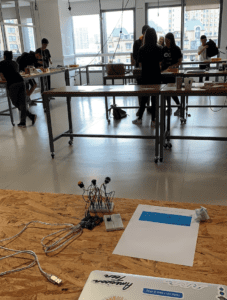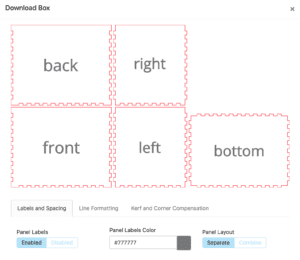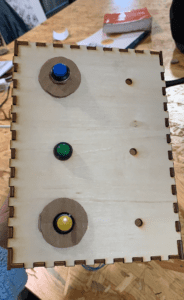CONTEXT AND SIGNIFICANCE:
For my midterm project, my partner and I decided to do a fun interactive game. Although this game and the concept of this game already exists, my partner and I still tried to challenge ourselves and re-create our own version of it. We brainstormed some ideas before actually deciding on our project, “Simon.” We chose this because it incorporated buttons, speakers, and LED lights that we could use all together and create one machine. Although this is sounds like a simple project, it was certainly challenging to accomplish. My previous group project didn’t really have that much inspiration for my midterm project but our basic understanding of interaction did carry through.
My definition of interaction is where there is a constant loop between the user and the machine. Likewise, when there is an input, there must be an output; if there isn’t an input, we programmed the game to keep running. “Simon” is obviously a recreation of the “Simon” game where it plays certain lights in a random order and it is up to the user to remember the order. We changed some aspects of the game as in when the user accidentally puts the wrong order, the game will replay the sequence that just went wrong; basically giving the user another chance.
Our project is intended for all ages. Originally I thought it would be more geared towards younger children since it would be a good game that gives them something to do. But I realized after we created this game, that many different students my age, around 18-20 also really enjoyed playing this game and it attracted their attention. I feel like this game is suitable for anyone no matter how old they are.
CONCEPTION AND DESIGN:
During User testing, my partner and I realized a lot of issues with our project when other students gave us input. For example, a lot of people felt that we should make our buttons so that they didn’t have to hold them each time it was being pressed since it was hard to switch around. I would agree because in the beginning, our game looked like a bunch of wires jumbled up together and the user couldn’t tell what they were supposed to do unless they were told to.
With that being said, we decided to laser print a box so that our buttons and LED lights could sit on top and the cables and everything else was hidden underneath. We selected laser printing because it would be more logical to create a box that way than to 3D print. We chose the wooden design just because we thought it would look more simple and clean that way.
Another option for us was to 3D print a box but we were told that it was not suggested to since we wanted a hollow box and it would most likely not come out the way we wanted to. To play it safe, we just went with the laser cutting because it was fast and better for our design.

- FABRICATION AND PRODUCTION:
During the fabrication process, we had to make a pdf version of what we hoped to be laser printed. This was challenging because both my partner and i have never done this before. At the same time, it was hard for us to measure the diameter of the buttons and LED lights to fit in the top of our box. After piecing it all together, we realized that the measurements were wrong so we had to improvise and cut out cardboard to place on top of the holes and hot glue around the LED lights.


- CONCLUSIONS:
The goal of our project was to create an interactive game that required an input in order to have an output. The result of our project basically sums up my definition of interaction because the game continues to play by itself unless there is an input and therefore an output will be played. Our audience reacted as expected, they were first trying to test out our game and it ultimately took a few tries. My partner and I made the mistake of not putting an explanation to the surface of our game so that our audience would at least know how to start the game. If we had more time, we would have made instructions or some type of recording that would give the user a queue to start and finish as well as directions.
After creating this game. I realized that there are so many different ways to show interaction. Overall, I am really happy with the outcome of our project because this is the most challenging machine that I have built/programmed. I have also learned that your first product will never be perfect and that there is always room to improve, even when you think that you’ve done your best.